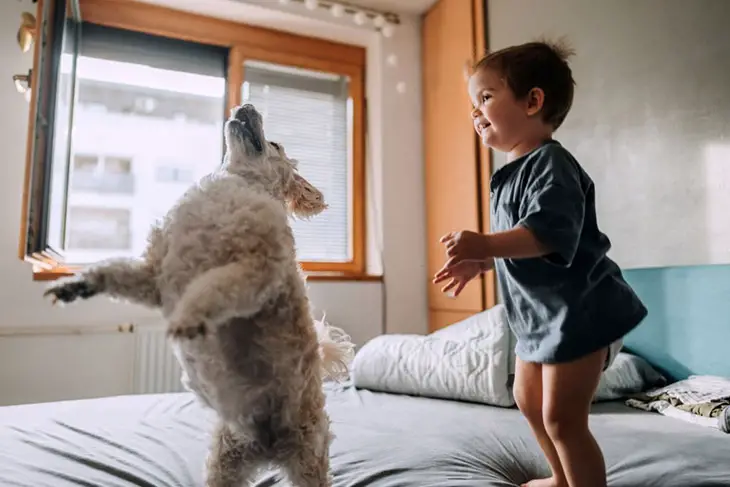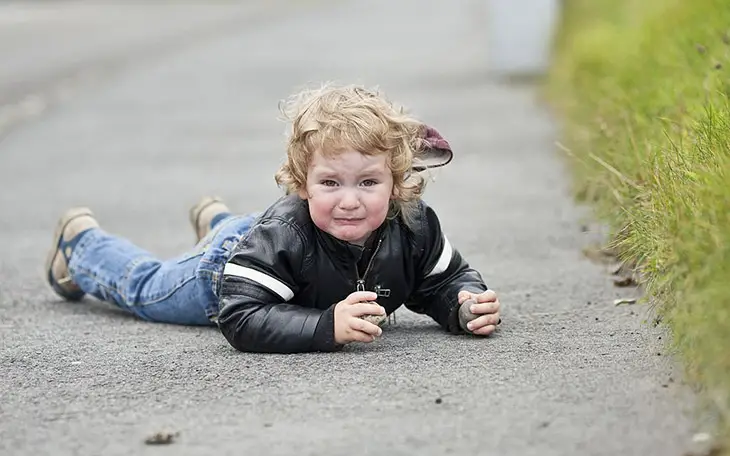To any parent, finding out that a 3 year old can’t jump with both feet could send them into panic. You might keep asking: why? Is there any problem with my little one?
We understand your concern and share all the ins and outs on this topic. Read on to get the exact information on this matter.
Why My 3 Year Old Can’t Jump With Both Feet?

It is quite normal for some special cases that kids don’t jump at both feet when they turn 3 because of lacking muscle strength or social interaction.
Some toddlers even wait until 4 or even forever to learn to jump.
They try to skip the phase, use the hopping or stepping-off skills, and focus on mental development. It happens to some advanced reader toddlers too.
In the end, all the skills (both mental and physical) balance out, and they lead to a normal life after all.
So generally, when do kids learn to jump? 16 to 18 months is the typical time.
And after 24 to 27 months, you can witness 2-feet jumping for toddlers. Most children at the age of 3 can jump with both feet, but not all.
Let’s dig deeper into the reasons:
Coordination & Motor Skills
They are still in the developing stage. When can kids jump? If you observe the coordination & motor skills of children at different ages, you will see 3-4 is the timeframe for such a development.
So by the time your toddler is 3, they haven’t fully developed these skills yet.
Just wait a little longer, as jumping in 2 feet requires many skills, such as timing, balance, and even strength of muscles.
Muscles Strength
When can toddlers jump? Now you know the answer, but if your kid tends to “refuse” this stage, your baby’s muscles are probably weak, hindering their balance skill.
Some neurological disorder or developmental delay is the cause of this.
Still, it is worth noting that each child has a different development stage. The normal range is not applied to any kids.
Some children have a slower pace than others but develop just fine.
Parents should encourage their babies to do more physical activities, and if there is any worry left, talk to a doctor for reassurance and support.
What Should Parents Do To Support Jumping For Toddlers?
When do toddlers learn to jump? When you find out the answer to the question, you should prepare everything to support your children so they can develop well at their pace.
Create A Posture
To develop motor skills, creating good posture is the first step. It will protect them from injury.
Besides, a proper stance can make jumping even easier. You can start by doing a sample jump like:
- Stand up, provided their shoulders are relaxed and their feet are separated by shoulder width.
- The knees should be slightly bent, and both feet should bear the same weight. It helps them keep balance to avoid falling over.
Then, keep an eye on your child so that if there is any strain or fatigue, you can encourage your baby to try again or take a break.
You can hold your child while you are jumping up; it will give your child a sense of jumping. Then, you can teach them how to do it on their own.
Use Tools
A jumping rope or trampoline is the best tool to support your babies when you look for the right advice for the question, when do kids start jumping?
The trampoline has a springy surface, providing a soft touch whenever your toddlers approach them.
There is no shock to make them startle when jumping on this. Therefore, parents do not have to worry about injury risk.
The jumping rope is the right tool to support your child’s coordination when they need to measure the time and the coordination of the arm, wrists, legs, and whole body.
Whatever tools you choose to support your child, don’t forget to read the manual and keep a sharp eye on them, so they are always safe and have help when needed.
You could bring them to playgrounds where many kids play. Or you organize some activities like father daughter activities for toddlers.
Children will learn from each other during these events or host a jumping rope or trampoline contest.
You will see a big improvement throughout social activists like this, supporting toddlers to learn to jump.
Besides, you can also brainstorm some activities on Hampton roads and include jumping in one of the games.
What Are Toddlers Supposed To Do When Jumping?

Eyes Focus
Keeping the eyes focused on an upward direction is encouraged.
Bend The Knees And Arms Behind The Body
This posture helps them to have the spring that jumping requires to lift off.
Swing The Arms Up And Forward
To have more force to lift the body.
Legs Straighten, Then Knees Bent
To land softly, they should land on the balls of the feet. It will prevent injuries and eliminate joint impacts.
Don’t Flail The Hands And Arms
They should keep them in control to maintain the balance and not fall over.
When Do Toddlers Start Jumping?
- At 2 years old: 50% of children can.
- At 2.25 years old: 75% of children can.
- At 3 years old: Almost all children can.
- At 4 years old: Children can jump over stepping stones.
- At 5 years old: Children can jump rope.
That is the answer to the question, when do toddlers jump at 2 feet?
Toddlers Learn To Jump Signs
When do babies jump? Generally speaking, most people will see their children jumping without any heads-up.
Still, if you spend more time and observe, here are some signs that your toddler is about to jumping phrase:
- There is no trouble for your children to cross obstacles. They do not fall over.
- They can easily walk across a pillow, cushion, and other similar surfaces.
That is the time.
Benefits Of Toddlers Jumping
Motor Skills
Develop children’s essential motor skills, including agility, balance, and coordination.
Besides, your baby’s muscles will be strengthened. Their other skills like walking, crawling & running will be improved from that.
Promote Bone Growth
Jumping can also support bone density. As a result, the bone will grow better, and osteoporosis risk will unlikely happen when your child grows up.
Ensure Cardiovascular Health
When your child runs, the hearts work better, boosting cardiovascular health.
Lung capacity will be improved too. Consequently, heart disease possibilities are limited.
Improve Cognitive Function
Jumping pushes up cognitive development by stimulating the brain.
Memory, processing speed, and attention are all improved. The mood will be fresh, and stress will be kept at bay.
Good For Social Interaction
Jumping increases the chance of your child interacting with other toddlers so that their social skills will develop.
They will learn how to share, take turns and know how to cooperate.
A Good Exercise For Imagination & Creativity
Jumping is important in helping your child discover more about the surrounding environment. They know what is difficult by understanding the limits.
The imagination will be stimulated too, when they find their way to play and jump more interestingly around their friends.
When Should Parents Worry?

Asymmetric Jumping
If your toddlers are at the age of jumping, but there are no signs they are about to do it, asymmetric jumping will be the first you should be concerned about.
Is your child always landing on the ground with one leg? Does your toddler drag one side? If yes, they are more likely in pain or the leg muscles are weak.
You should call the doctor and ask for appointments in this case.
You See No Strength When They Push Off
Have you seen your babies squat but have no strength in their legs to push them forward? If there is a yes, you need medical advice to know the cause.
Frequent Falls
Does your child frequently fall? Do the knees often buckle? Well, if yes, it is a red flag. You should put a question on it.
Unexplained Behavior When You Ask For A Jump
If your child begins to lose the temple every time you ask them to try to jump, or they always ask you to “up” “up,” then there is probably an underlying impairment that you need a doctor’s advice because they may feel that the skill is too scary for them.
Final Thoughts
That is everything to know when a 3 year old can’t jump with both feet.
Jumping is a good activity to support toddlers in developing both physical and mental health. Therefore, parents should observe and support them to grow their skills as soon as possible.
By giving them more time and understanding the cause and the process, you will lead them to nail this skill easier.
